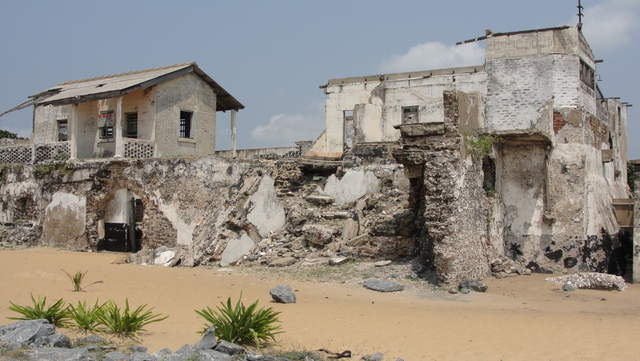Located at a breathtaking ocean view spot along the coast of Keta, Fort Prinzenstein has transformed from what used to be a magnificent edifice to remnants of eroded blocks waiting to cave in.
This Fort was among the four major Danish structures in Ghana, built in the commercial capital of the 36 Anlo towns in 1784 AD.
This historic building served a significant purpose in the slave trade involving Europeans in West Africa, the Caribbean and the southern USA. Apart from a small fort in Benin and Senegal, the fort at Keta is the only ancient European-built fort of its kind east of the Volta River, which is close to the slave coast of Dahomey (Benin).
Caretaker of the place, James Ocloo Akorli told this reporter portions of the fort has been pulled down by sea waves. He however noted that a significant portion remains to tell a sad story.
About 2/3 of the fort has so far been destroyed with seven out of the ten slave dungeons gone with the sea waves.
The site has earned a spot among ten fast-growing tourist destinations in Ghana competing with sites such as the Wli Waterfalls, Mount Gemi, Afadzato, Tagbo Falls, and Tafi Atome Monkey Sanctuary among others.
In November 2020, the Minister in charge of Tourism, Arts and Culture, Barbara Oteng-Gyasi at a press briefing in Accra said government had plans of revamping tourist sites in the country to boost efforts by private stakeholders in the tourism sector.
According to the Minister, the move is part of government’s Tourism Development Project that seeks to embark on the revamping and diversification of existing tourist sites as well as the development of new ones.
“I indicated that we are looking at diversifying our sites. That is bringing onboard new sites that will give varied experience and also improving the existing ones. In view of Paga, we are investing about 800,000 dollars to develop the Paga Crocodile Pond under the Ghana Tourism Development Project,” she said.
While Ghana still has a lot to achieve in becoming a destination of choice on the African continent, the Medium-Term Expenditure Framework of the Ministry of Tourism, Arts and Culture stated that, in 2017, the sector contributed GHS12.58bn ($2.7bn), which translates to 6.2% of the national GDP, to the economy. A total of 1.3m international tourists visited the country that same year, representing a 6% increase from the 2016 figure.
Over the years, the tourism industry in Ghana has played an indispensable role in the socio-economic developments of the country through employment creation, tax revenues, and income in the area.
Be that as it may, it is essential that deteriorating sites such as Fort Prinzenstein are saved from dying. This is obviously the only way the country can gain the full complement of tourism.
Source: Newswatchgh.com



